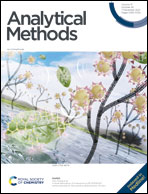A UHPLC-Q-TOF/MS method for the determination of poloxamer 124 and its application in a tissue distribution study in rats
Abstract
Poloxamers are commonly used pharmaceutical excipients. They are high molecular weight polymers formed from polypropylene oxide (PPO) and polyethylene oxide (PEO). However, PL124, a low molecular weight example in the poloxamer family, has rarely been reported, and there is no research into its tissue distribution in the body after administration. In this study, rat tissue samples were quantitatively studied via UHPLC-Q-TOF/MS after the intravenous administration of 10 mg kg−1 PL124. The quantitative method showed good sensitivity and selectivity. The linear range of PL124 was 0.1–5 μg mL−1 and the LLOQ was 0.1 μg mL−1. The relative error in terms of the accuracy was no higher than 13.9%, and the relative standard deviation in terms of the precision was no higher than 9.6%. The extraction recovery, matrix effect, and stability results of the established method were also satisfactory. The research showed that PL124 can be quickly distributed to large amounts of tissue, and tissue with higher levels of blood flow has higher concentrations. PL124 could be rapidly eliminated in 4 h from most organs, except the heart and liver. This study can be helpful for the further analysis of PL124.



 Please wait while we load your content...
Please wait while we load your content...